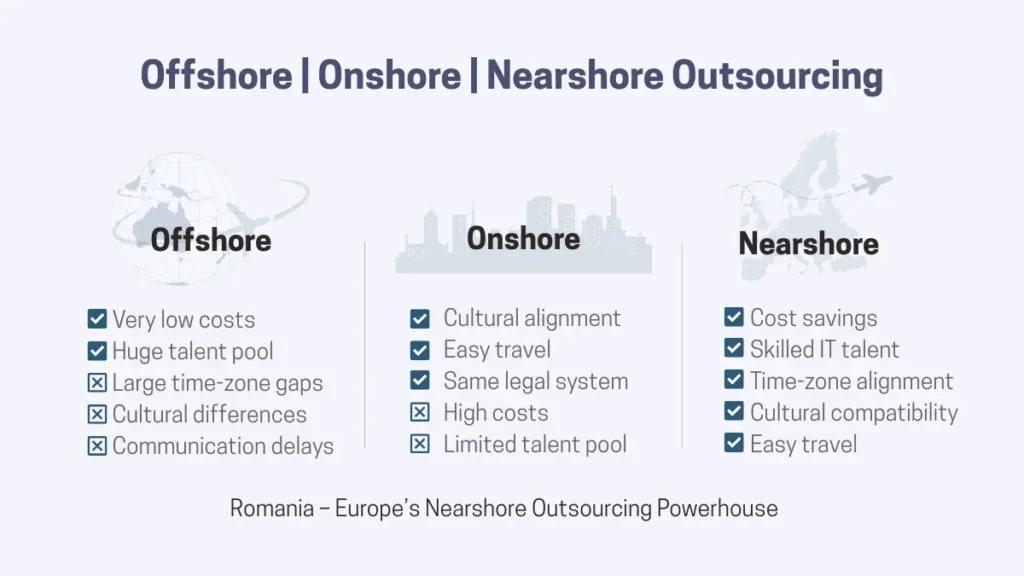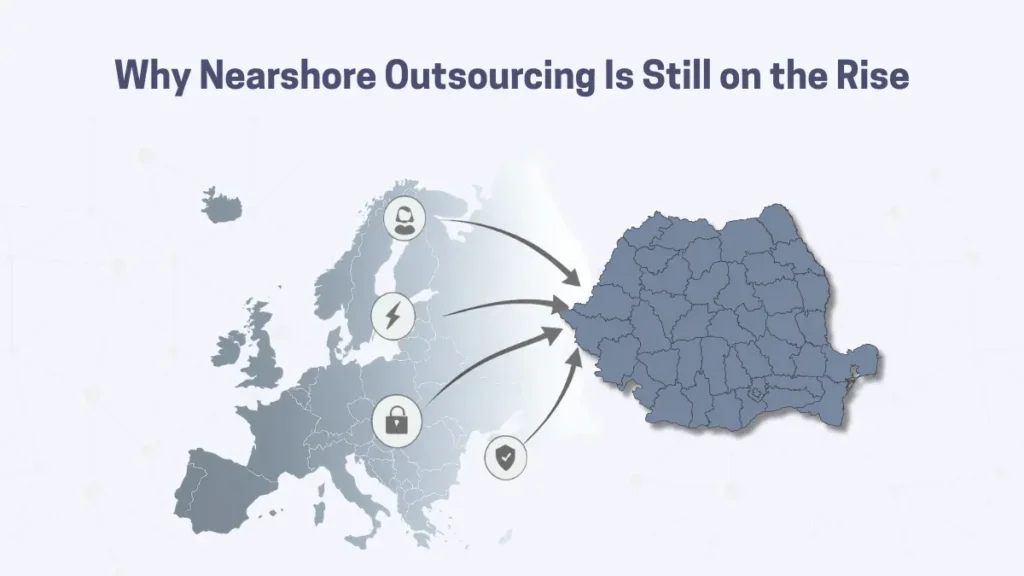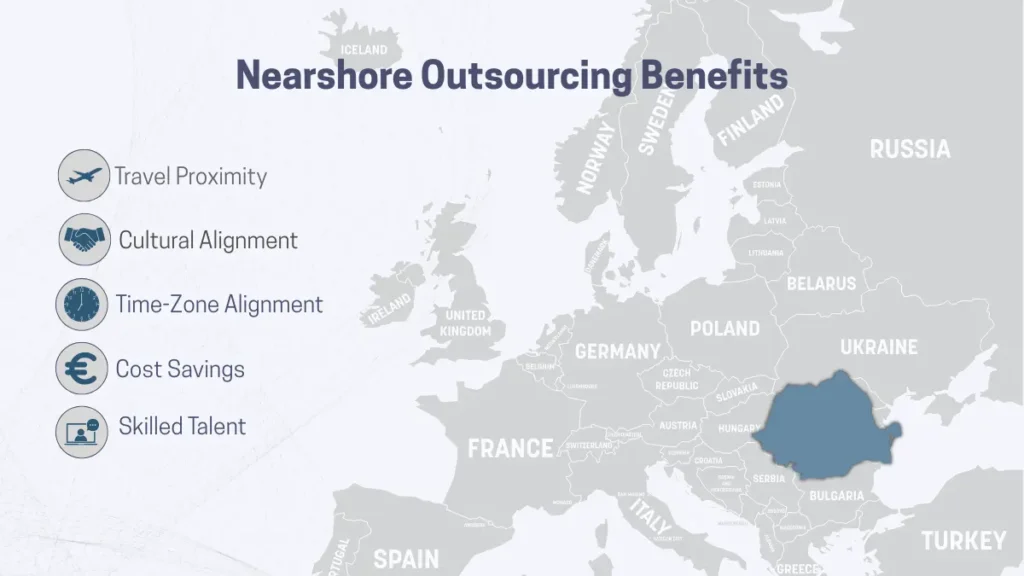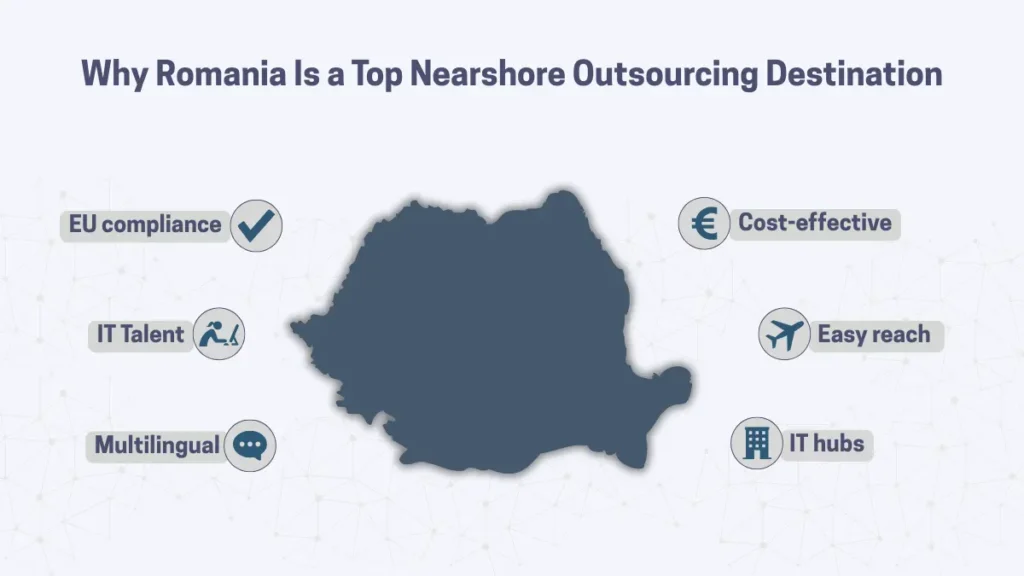Reading time: 8 minutes
Across Western countries, the software development industry is under constant pressure to deliver more digital innovation, as fast and as cost-effectively as possible. At the same time, it needs to overcome shortages of IT talent, rising in-house expenses, as well as global competition.
This is what outsourcing solves. For years, businesses have turned to external partners to expand their teams and reduce costs. Offshore outsourcing to countries like India or the Philippines has long been popular. In 2025, nearshore outsourcing is the preferred choice for many European businesses looking to balance costs and quality.
Nearshore outsourcing offers the cost savings of offshore while also providing the cultural and time-zone benefits of onshore. This balance creates the best of both worlds. For European companies, Romania is an established destination.
Next, we will discuss what nearshore outsourcing is, how it differs from offshore and onshore models, and why more software companies are choosing Romanian software companies for outsourcing.
The Current Outsourcing Models
What are the checkpoints for the three major outsourcing models of onshore, offshore, and nearshore?

Onshore Outsourcing
In onshore outsourcing, the contracts are made with service providers working within the same country. For example, a German company outsourcing IT development to another German city.
Pros:
- Strong cultural alignments
- Legal familiarity
- Minimal communication barriers
- Easy collaboration (face-to-face interaction)
Cons:
- Costs are relatively high still, close to those of in-house
- Limited talent pool as only resources of one country are considered
Offshore Outsourcing
Offshore outsourcing refers to outsourcing work to countries located far away, usually on other continents. For example, a company in the UK gets work done in India.
Pros:
- Large talent pools
- Lower hourly rates as compared to Western Europe
Cons:
- Major time-zone differences cause lengthy delays in collaboration
- Gaps in culture and business procedures
- Language and quality variation barriers
Nearshore Outsourcing
Nearshore outsourcing means working with companies located in the neighboring or nearby countries generally within a 1- to 3-hour time difference. For instance, companies from Germany, Austria, or Switzerland working with Romanian IT teams.
Pros:
- Cost savings compared to onshore
- More cultural and linguistic alignment compared to offshore
- Easier travel for workshops and team-buildings
- Common or overlapping working hours
This is the middle-ground arrangement, which is why nearshore outsourcing remains quite popular in 2025.
Why Nearshore Outsourcing Is Still on the Rise
Outsourcing aims to make the most of resources. In 2025, the priorities of European companies go beyond simple cost cutting. Nearshore outsourcing is a way to balance speed, quality, compliance, and flexibility. Here are some business and technology trends that explain its growth:

Talent Shortage in Western Europe
The demand for skilled software engineers in Western Europe keeps exceeding supply. Western countries face a constant shortage of IT professionals. Recruitment is slow and expensive. Nearshore locations like Romania offer access to a large, well-educated talent pool. This allows Western companies to grow their development teams without the lengthy hiring processes and high salaries needed locally.
Pressure to Innovate Quickly
Digital transformation is essential for a company’s survival. Companies are rushing to update outdated systems, move to the cloud, and adopt AI-driven solutions. This urgency requires agile teams that can deliver fast results. By partnering with nearshore providers, companies can quickly boost their internal capacity, ensuring that projects do not stall due to a lack of resources.
Remote Collaboration as the Norm
The pandemic changed how businesses approach teamwork. Tools for remote collaboration like Slack, Teams, and Jira have normalized working across locations and even countries. In this context, nearshore outsourcing becomes a natural extension of hybrid work models. Teams are close enough, work during overlapping hours, and blend into the client’s daily workflows.
Legal Compliance and Security Needs
For European businesses, data protection is a must. Regulations like GDPR impose strict rules on handling sensitive data. By outsourcing to an EU country like Romania, companies ensure that their nearshore partner meets the same legal and data security standards. This reduces compliance risks that are tougher to manage with offshore partners outside Europe.
Strategic Agility
Besides saving money, companies require outsourcing partnerships that improve business agility. Nearshore outsourcing provides this benefit. Partners are close enough for real-time collaboration and in-person workshops, yet their costs remain manageable. This combination allows companies to quickly respond, whether scaling teams up or down, trying new technologies, or entering new markets.
These factors make nearshore outsourcing not just a temporary solution but a long-term strategic choice. It helps European companies address talent shortages, speed up innovation, ensure compliance, and stay competitive in a rapidly changing digital economy.
The Main Benefits of Nearshore Outsourcing
We should take a look at the main benefits software companies get when they choose nearshore outsourcing compared to onshore or offshore setups.

Cultural Alignment and Communication
A cultural alignment is most often overlooked in outsourcing. Work habits, expectations, or communication errors are inducing delays in projects, along with tensions. European nearshore partners often have similar cultural values and customs as their Western European clients.
As an example, Romania has a solid reputation for collaboration with English- and German-speaking markets. Teams are well familiar with Western work habits like punctuality, transparency, and accountability, which makes the integration much easier.
Language skills are another significant advantage. Romanian IT professionals speak high-level English as a rule, and many of them also speak French or German. This reduces communication obstacles almost entirely, which means simpler requirements, fewer errors, and faster agreement between clients and suppliers.
Time-Zone Alignment
A significant challenge of offshore outsourcing is the time-zone differential. While your team in Europe is closing its day, your offshore partner is just beginning theirs, and vice versa. This can create delays of 12 to 24 hours for even simple updates.
Nearshore outsourcing has a workday overlap almost completely. This allows:
- Real-time discussions and feedback.
- Faster decision-making and problem-solving.
- Agile practices, like daily stand-ups, that work across borders.
In practice, this means projects happening faster, deadlines being fewer issues, and collaboration with others feeling more natural.
Cost Savings with High Quality
Nearshore outsourcing balances cost efficiency and quality. Hiring IT staff in Western Europe is expensive due to high salaries, taxes, and overhead. Offshoring might be cheaper, but it brings risks like miscommunication, rework, and quality inconsistencies, which can raise the total cost.
Nearshore outsourcing minimizes cost compared to onshore hiring but retains European standards of education, compliance, and professionalism. Through this option, companies can:
- Minimize recruitment and staffing costs.
- Offer fair but competitive salaries.
- Avoid sneaky expenses from poor quality or delayed delivery.
This leaves companies with more ROI at much lower risks.
Access to Skilled IT Talent
Western European talent shortage is the biggest concern for businesses in this day and age. With the use of nearshore teams, businesses are given access to an immense pool of extremely skilled talent.
Romania alone produces thousands of information technology graduates every year. These are trained in international technology skills that can be applied globally, including:
- .NET, Java, and Python for application development.
- React, Angular, and Vue.js for web.
- Swift and Kotlin for mobile applications.
- Cloud platforms including Azure, AWS, and Google Cloud.
- AI, machine learning, and data science for innovation projects.
What it means is that organizations are not just gaining more developers but talent with the specific skillset needed to speed up digital transformation projects.
Simplified Travel and In-Person Meetings
Trust develops quicker when individuals meet in person. While offshore partners may be over 10 hours away by flight, nearshore teams are just a quick flight away.
For German, Austrian, or Swiss firms, Romania is under less than 2 to 3 hours. Thus, it is easy to:
- Organize kick-off workshops at the start of projects.
- Schedule quarterly in-person reviews.
- Encourage team camaraderie through onsite or hybrid work.
These face-to-face interactions reinforce long-term relationships and develop the kind of trust that sometimes escapes remote collaborations.
Nearshore outsourcing combines the best of onshore and offshore models: cultural fit, real-time collaboration, cost-effectiveness, access to expert talent, and proximity for more meaningful relationships.
Why Romania Is a Top Nearshore Outsourcing Destination
Romania is a popular nearshore hub in Europe. Here’s why:

EU Membership & Compliance
Romania is part of the European Union and adheres to the same legal and data protection regulations as the EU, such as GDPR. This makes companies feel assured.
Large IT Talent Pool
Romania issues thousands of IT engineers each year as universities graduate them. The country ranks among the top in Europe for tech education.
Multilingual Workforce
Many Romanian developers speak English, German, and French. This makes communication smooth.
Cost-Effective Prices
Hourly rates are much lower than in Western Europe with no cost-cutting to the quality.
Easy Reach
Romania is just 1 to 3 hours away by flight from cities like Munich, Vienna, and Zurich. This makes it easy for teams to meet in person.
Influential IT Environment
With major technology hubs in Cluj-Napoca, Bucharest, and Timisoara, Romania has a thriving IT services market serving global clients.
This mix of quality, affordability, and closeness makes Romania a natural choice for European companies looking for nearshore outsourcing partners.
Ambo Software: Your Nearshore Outsourcing Partner in Romania
At Ambo Software, we help Western companies to augment their IT capabilities with reliable nearshore outsourcing services.
We are located in Cluj-Napoca and Satu Mare, Romania. Both locations have international airports, facilitating convenient traveling for face-to-face interactions, onsite trainings, and regular visits.
We focus on industrial software, along with custom software development, mobile apps, web platforms, and desktop applications. Our technology stack includes: Java, C#/.NET (Core, Framework, ASP.NET), C++, JavaScript, Kotlin, Swift, PHP, Delphi..
We have successfully implemented projects for German, Austrian, and Swiss customers, as well as clients all over the world, since 1999.
We have seasoned developers with a solid technical background and great communication skills, willing to integrate into your operations. Our teams are adaptable, professional, multilingual, and accustomed to working with Western European clients. We know that outsourcing is not just about reducing costs; it is about establishing a dependable, long-term partnership based on quality, transparency, and mutual growth.
*****
Nearshore outsourcing is more than just a trend; it is the way of IT co-operation in Europe in the future. It satisfies cost savings with cultural and time zone compatibility. This provides companies with the ease to scale, innovate, and compete globally.
For a European company, Romania is a nearshore destination. It has a skilled manpower force, EU compliance, and wonderful proximity.
If you’re ready to take nearshore outsourcing in Romania into account, contact Ambo Software today. Learn how we can help accelerate your next IT project.

